Management Accounting for Cost Control at Lake Ltd. Analysis
VerifiedAdded on 2023/06/12
|18
|2151
|67
Report
AI Summary
This report delves into the principles of management accounting, contrasting it with financial accounting and elucidating its core functions such as planning, organizing, controlling, and decision-making. It examines the relevance of concepts like panopticism in ensuring control and discipline within organizations. The report includes a detailed manufacturing statement, cost of goods sold schedule, and income statement for Lake Ltd., alongside calculations for manufacturing overhead rates and job costing. Furthermore, it analyzes overhead allocation methods, including direct, step-down, and reciprocal methods, to determine accurate departmental costs. The report also explores traditional costing systems versus activity-based costing (ABC), demonstrating how ABC provides a more accurate understanding of product profitability by assigning overhead costs based on activities. This comprehensive analysis provides insights into effective cost management and decision-making within a manufacturing context; this assignment is available for review and learning on Desklib, a platform providing study tools for students.
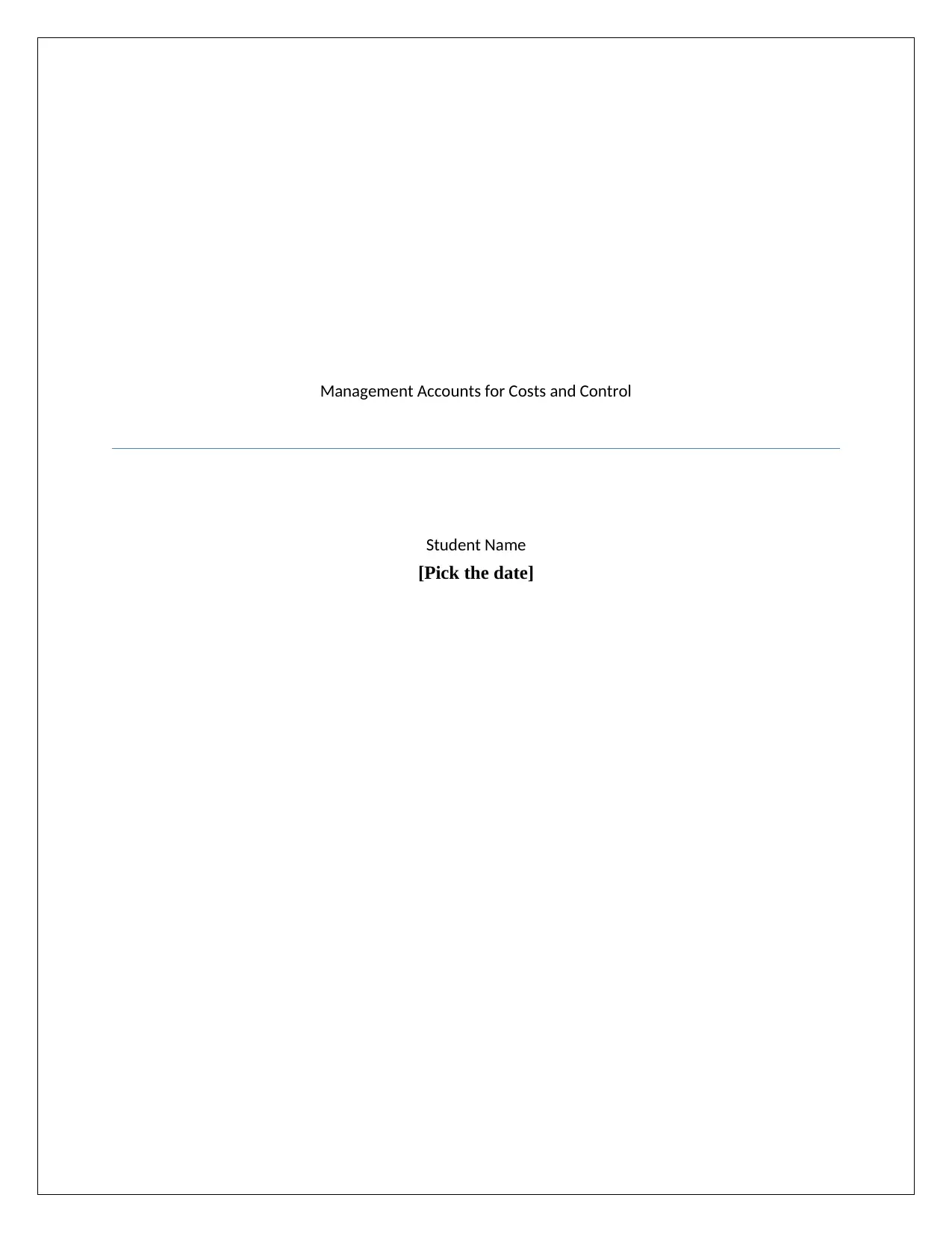
Management Accounts for Costs and Control
Student Name
[Pick the date]
Student Name
[Pick the date]
Secure Best Marks with AI Grader
Need help grading? Try our AI Grader for instant feedback on your assignments.
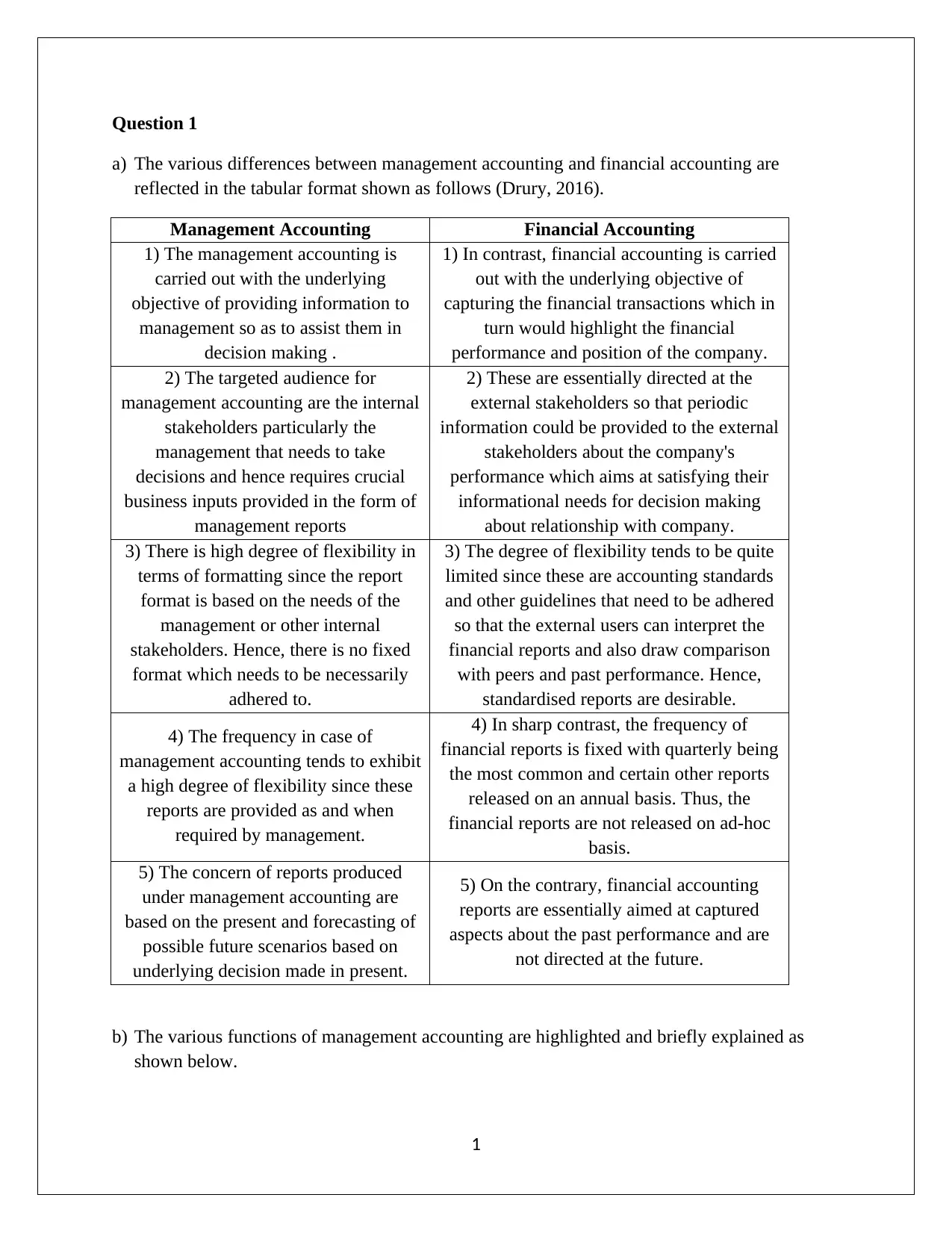
Question 1
a) The various differences between management accounting and financial accounting are
reflected in the tabular format shown as follows (Drury, 2016).
Management Accounting Financial Accounting
1) The management accounting is
carried out with the underlying
objective of providing information to
management so as to assist them in
decision making .
1) In contrast, financial accounting is carried
out with the underlying objective of
capturing the financial transactions which in
turn would highlight the financial
performance and position of the company.
2) The targeted audience for
management accounting are the internal
stakeholders particularly the
management that needs to take
decisions and hence requires crucial
business inputs provided in the form of
management reports
2) These are essentially directed at the
external stakeholders so that periodic
information could be provided to the external
stakeholders about the company's
performance which aims at satisfying their
informational needs for decision making
about relationship with company.
3) There is high degree of flexibility in
terms of formatting since the report
format is based on the needs of the
management or other internal
stakeholders. Hence, there is no fixed
format which needs to be necessarily
adhered to.
3) The degree of flexibility tends to be quite
limited since these are accounting standards
and other guidelines that need to be adhered
so that the external users can interpret the
financial reports and also draw comparison
with peers and past performance. Hence,
standardised reports are desirable.
4) The frequency in case of
management accounting tends to exhibit
a high degree of flexibility since these
reports are provided as and when
required by management.
4) In sharp contrast, the frequency of
financial reports is fixed with quarterly being
the most common and certain other reports
released on an annual basis. Thus, the
financial reports are not released on ad-hoc
basis.
5) The concern of reports produced
under management accounting are
based on the present and forecasting of
possible future scenarios based on
underlying decision made in present.
5) On the contrary, financial accounting
reports are essentially aimed at captured
aspects about the past performance and are
not directed at the future.
b) The various functions of management accounting are highlighted and briefly explained as
shown below.
1
a) The various differences between management accounting and financial accounting are
reflected in the tabular format shown as follows (Drury, 2016).
Management Accounting Financial Accounting
1) The management accounting is
carried out with the underlying
objective of providing information to
management so as to assist them in
decision making .
1) In contrast, financial accounting is carried
out with the underlying objective of
capturing the financial transactions which in
turn would highlight the financial
performance and position of the company.
2) The targeted audience for
management accounting are the internal
stakeholders particularly the
management that needs to take
decisions and hence requires crucial
business inputs provided in the form of
management reports
2) These are essentially directed at the
external stakeholders so that periodic
information could be provided to the external
stakeholders about the company's
performance which aims at satisfying their
informational needs for decision making
about relationship with company.
3) There is high degree of flexibility in
terms of formatting since the report
format is based on the needs of the
management or other internal
stakeholders. Hence, there is no fixed
format which needs to be necessarily
adhered to.
3) The degree of flexibility tends to be quite
limited since these are accounting standards
and other guidelines that need to be adhered
so that the external users can interpret the
financial reports and also draw comparison
with peers and past performance. Hence,
standardised reports are desirable.
4) The frequency in case of
management accounting tends to exhibit
a high degree of flexibility since these
reports are provided as and when
required by management.
4) In sharp contrast, the frequency of
financial reports is fixed with quarterly being
the most common and certain other reports
released on an annual basis. Thus, the
financial reports are not released on ad-hoc
basis.
5) The concern of reports produced
under management accounting are
based on the present and forecasting of
possible future scenarios based on
underlying decision made in present.
5) On the contrary, financial accounting
reports are essentially aimed at captured
aspects about the past performance and are
not directed at the future.
b) The various functions of management accounting are highlighted and briefly explained as
shown below.
1
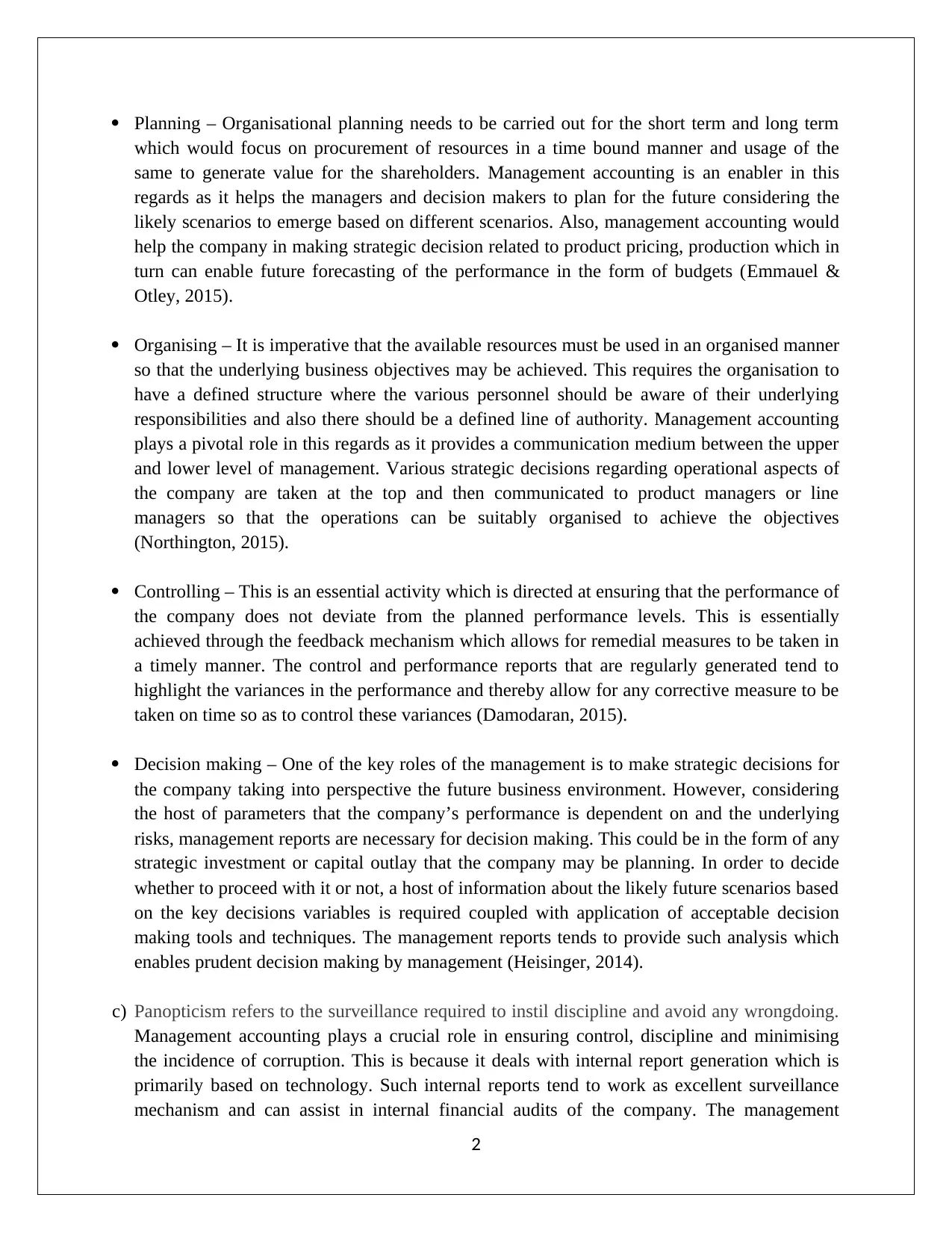
Planning – Organisational planning needs to be carried out for the short term and long term
which would focus on procurement of resources in a time bound manner and usage of the
same to generate value for the shareholders. Management accounting is an enabler in this
regards as it helps the managers and decision makers to plan for the future considering the
likely scenarios to emerge based on different scenarios. Also, management accounting would
help the company in making strategic decision related to product pricing, production which in
turn can enable future forecasting of the performance in the form of budgets (Emmauel &
Otley, 2015).
Organising – It is imperative that the available resources must be used in an organised manner
so that the underlying business objectives may be achieved. This requires the organisation to
have a defined structure where the various personnel should be aware of their underlying
responsibilities and also there should be a defined line of authority. Management accounting
plays a pivotal role in this regards as it provides a communication medium between the upper
and lower level of management. Various strategic decisions regarding operational aspects of
the company are taken at the top and then communicated to product managers or line
managers so that the operations can be suitably organised to achieve the objectives
(Northington, 2015).
Controlling – This is an essential activity which is directed at ensuring that the performance of
the company does not deviate from the planned performance levels. This is essentially
achieved through the feedback mechanism which allows for remedial measures to be taken in
a timely manner. The control and performance reports that are regularly generated tend to
highlight the variances in the performance and thereby allow for any corrective measure to be
taken on time so as to control these variances (Damodaran, 2015).
Decision making – One of the key roles of the management is to make strategic decisions for
the company taking into perspective the future business environment. However, considering
the host of parameters that the company’s performance is dependent on and the underlying
risks, management reports are necessary for decision making. This could be in the form of any
strategic investment or capital outlay that the company may be planning. In order to decide
whether to proceed with it or not, a host of information about the likely future scenarios based
on the key decisions variables is required coupled with application of acceptable decision
making tools and techniques. The management reports tends to provide such analysis which
enables prudent decision making by management (Heisinger, 2014).
c) Panopticism refers to the surveillance required to instil discipline and avoid any wrongdoing.
Management accounting plays a crucial role in ensuring control, discipline and minimising
the incidence of corruption. This is because it deals with internal report generation which is
primarily based on technology. Such internal reports tend to work as excellent surveillance
mechanism and can assist in internal financial audits of the company. The management
2
which would focus on procurement of resources in a time bound manner and usage of the
same to generate value for the shareholders. Management accounting is an enabler in this
regards as it helps the managers and decision makers to plan for the future considering the
likely scenarios to emerge based on different scenarios. Also, management accounting would
help the company in making strategic decision related to product pricing, production which in
turn can enable future forecasting of the performance in the form of budgets (Emmauel &
Otley, 2015).
Organising – It is imperative that the available resources must be used in an organised manner
so that the underlying business objectives may be achieved. This requires the organisation to
have a defined structure where the various personnel should be aware of their underlying
responsibilities and also there should be a defined line of authority. Management accounting
plays a pivotal role in this regards as it provides a communication medium between the upper
and lower level of management. Various strategic decisions regarding operational aspects of
the company are taken at the top and then communicated to product managers or line
managers so that the operations can be suitably organised to achieve the objectives
(Northington, 2015).
Controlling – This is an essential activity which is directed at ensuring that the performance of
the company does not deviate from the planned performance levels. This is essentially
achieved through the feedback mechanism which allows for remedial measures to be taken in
a timely manner. The control and performance reports that are regularly generated tend to
highlight the variances in the performance and thereby allow for any corrective measure to be
taken on time so as to control these variances (Damodaran, 2015).
Decision making – One of the key roles of the management is to make strategic decisions for
the company taking into perspective the future business environment. However, considering
the host of parameters that the company’s performance is dependent on and the underlying
risks, management reports are necessary for decision making. This could be in the form of any
strategic investment or capital outlay that the company may be planning. In order to decide
whether to proceed with it or not, a host of information about the likely future scenarios based
on the key decisions variables is required coupled with application of acceptable decision
making tools and techniques. The management reports tends to provide such analysis which
enables prudent decision making by management (Heisinger, 2014).
c) Panopticism refers to the surveillance required to instil discipline and avoid any wrongdoing.
Management accounting plays a crucial role in ensuring control, discipline and minimising
the incidence of corruption. This is because it deals with internal report generation which is
primarily based on technology. Such internal reports tend to work as excellent surveillance
mechanism and can assist in internal financial audits of the company. The management
2
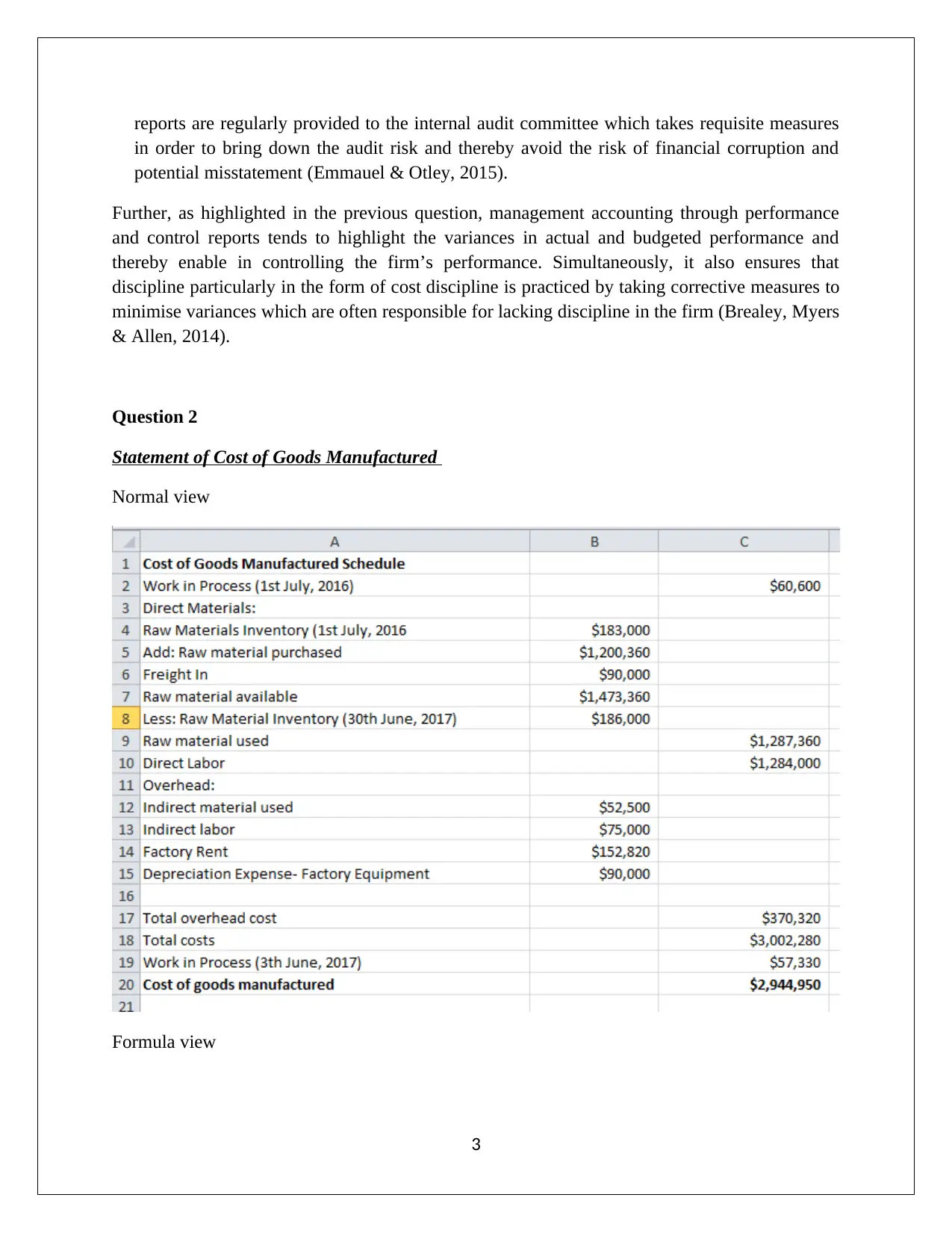
reports are regularly provided to the internal audit committee which takes requisite measures
in order to bring down the audit risk and thereby avoid the risk of financial corruption and
potential misstatement (Emmauel & Otley, 2015).
Further, as highlighted in the previous question, management accounting through performance
and control reports tends to highlight the variances in actual and budgeted performance and
thereby enable in controlling the firm’s performance. Simultaneously, it also ensures that
discipline particularly in the form of cost discipline is practiced by taking corrective measures to
minimise variances which are often responsible for lacking discipline in the firm (Brealey, Myers
& Allen, 2014).
Question 2
Statement of Cost of Goods Manufactured
Normal view
Formula view
3
in order to bring down the audit risk and thereby avoid the risk of financial corruption and
potential misstatement (Emmauel & Otley, 2015).
Further, as highlighted in the previous question, management accounting through performance
and control reports tends to highlight the variances in actual and budgeted performance and
thereby enable in controlling the firm’s performance. Simultaneously, it also ensures that
discipline particularly in the form of cost discipline is practiced by taking corrective measures to
minimise variances which are often responsible for lacking discipline in the firm (Brealey, Myers
& Allen, 2014).
Question 2
Statement of Cost of Goods Manufactured
Normal view
Formula view
3
Secure Best Marks with AI Grader
Need help grading? Try our AI Grader for instant feedback on your assignments.
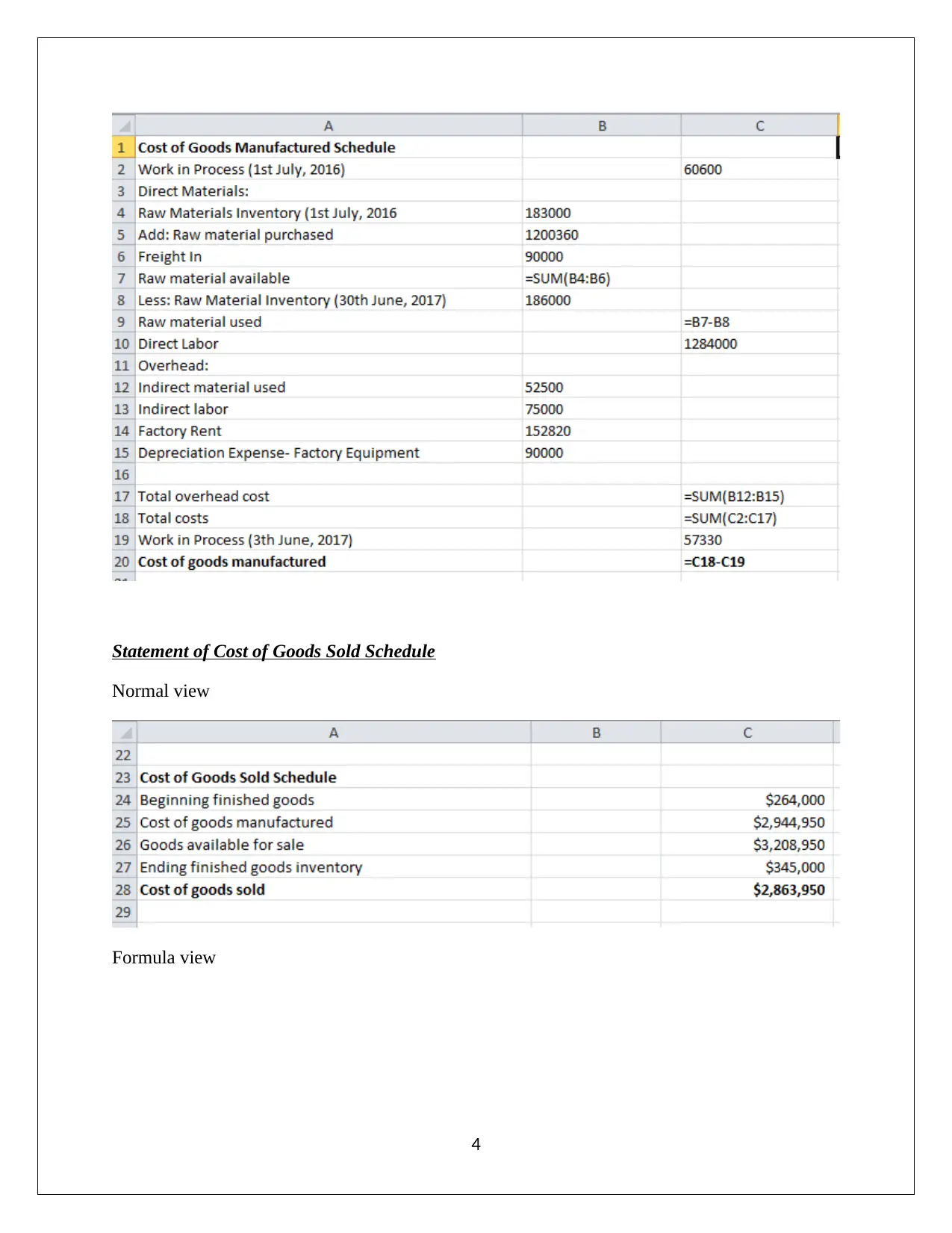
Statement of Cost of Goods Sold Schedule
Normal view
Formula view
4
Normal view
Formula view
4
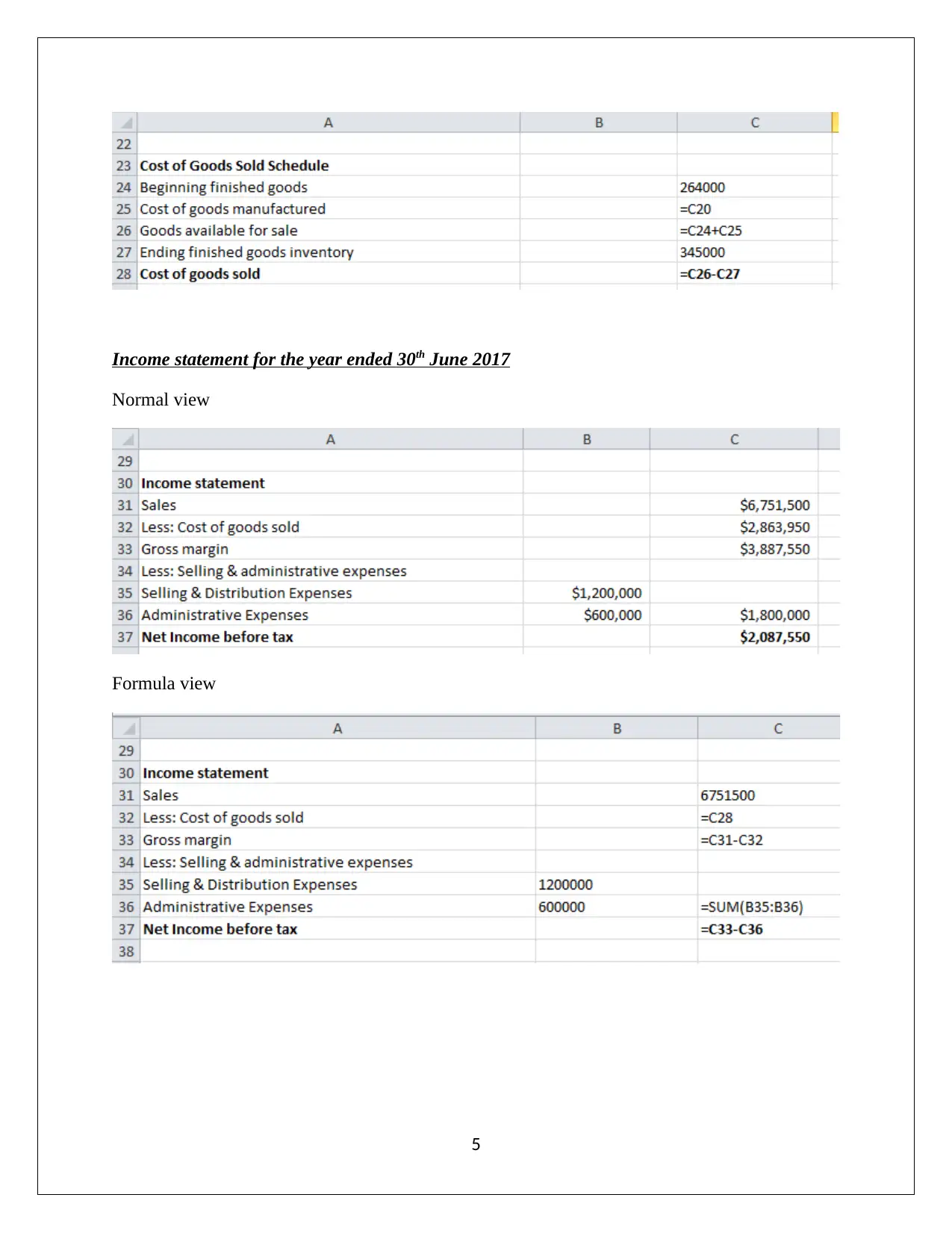
Income statement for the year ended 30th June 2017
Normal view
Formula view
5
Normal view
Formula view
5
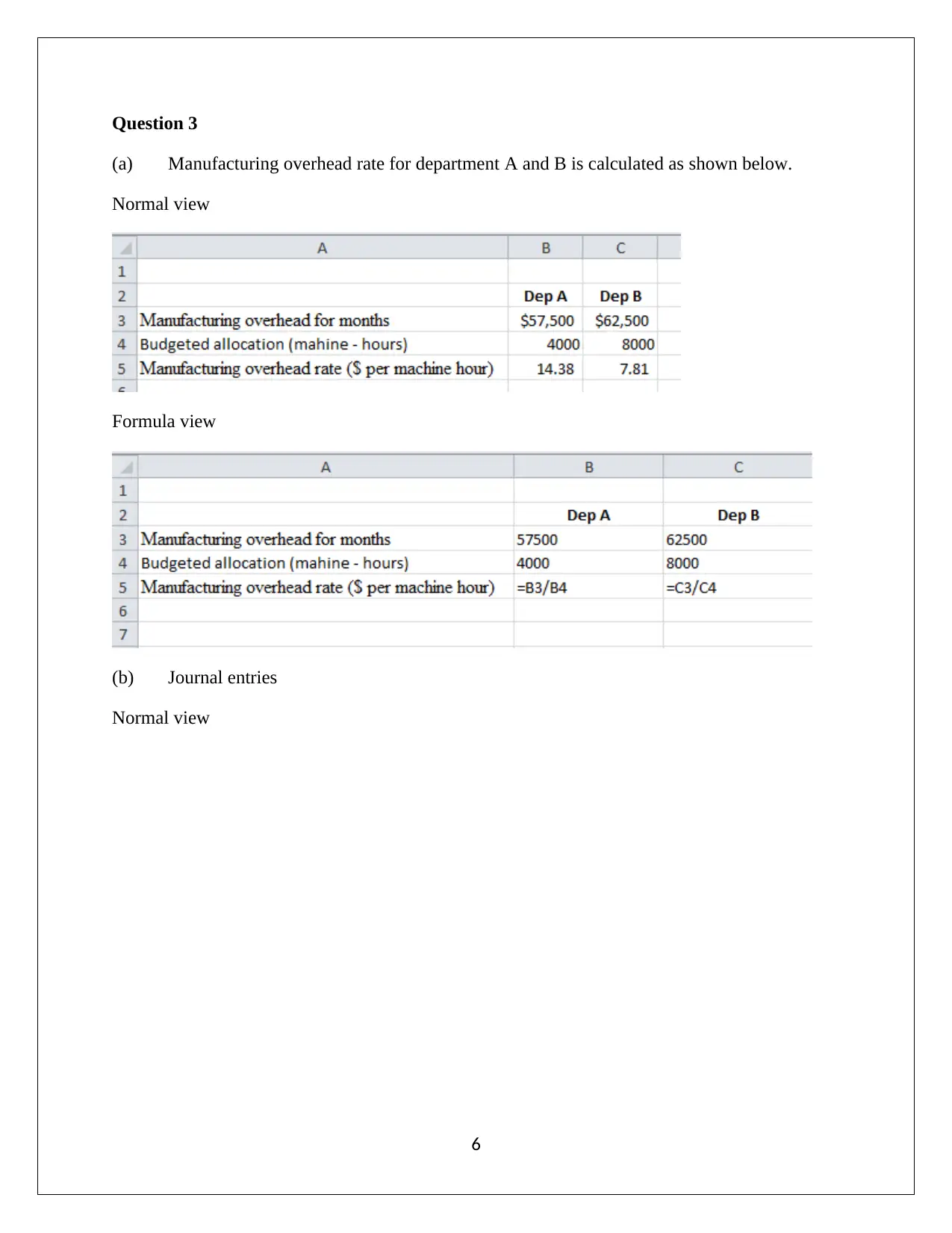
Question 3
(a) Manufacturing overhead rate for department A and B is calculated as shown below.
Normal view
Formula view
(b) Journal entries
Normal view
6
(a) Manufacturing overhead rate for department A and B is calculated as shown below.
Normal view
Formula view
(b) Journal entries
Normal view
6
Paraphrase This Document
Need a fresh take? Get an instant paraphrase of this document with our AI Paraphraser
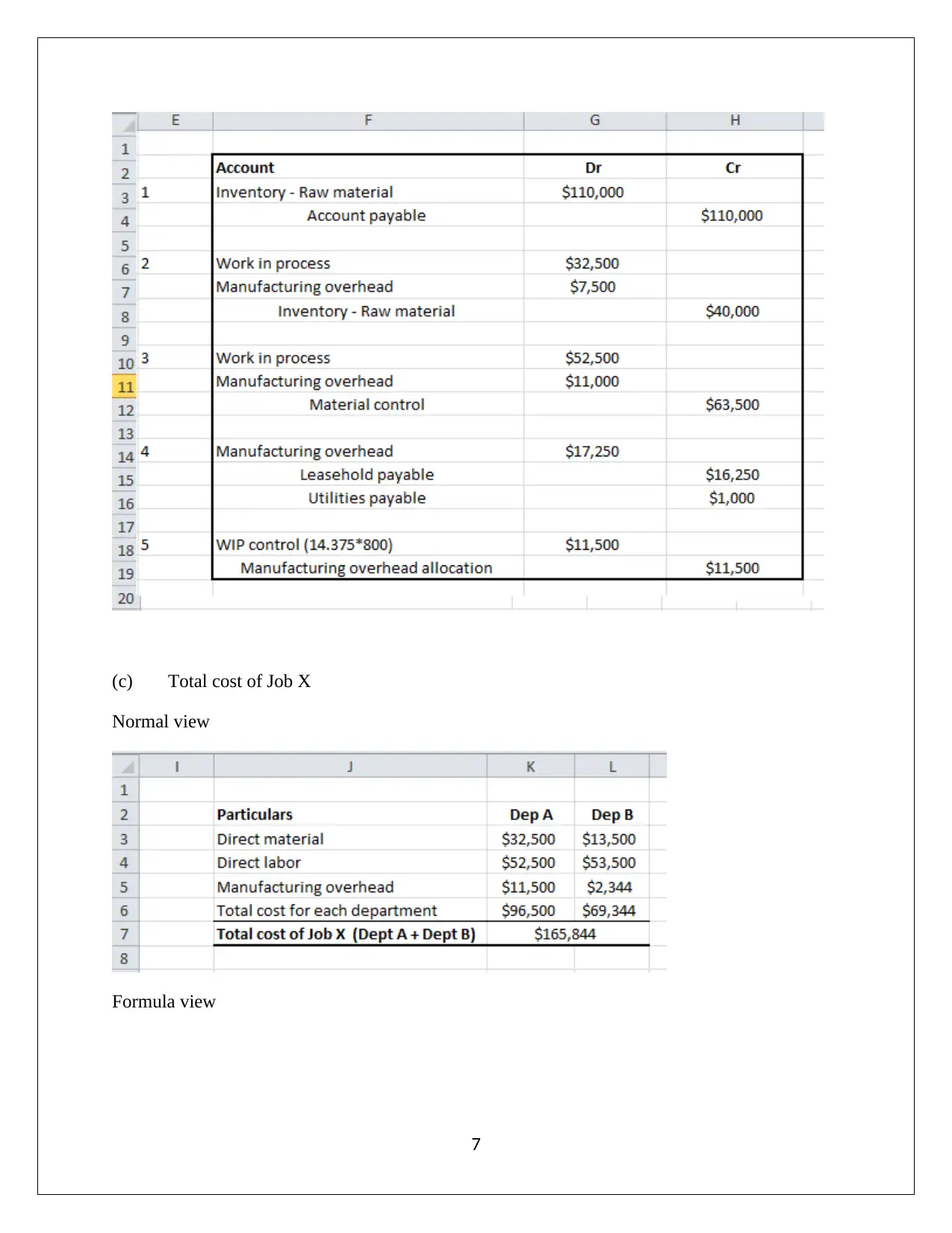
(c) Total cost of Job X
Normal view
Formula view
7
Normal view
Formula view
7
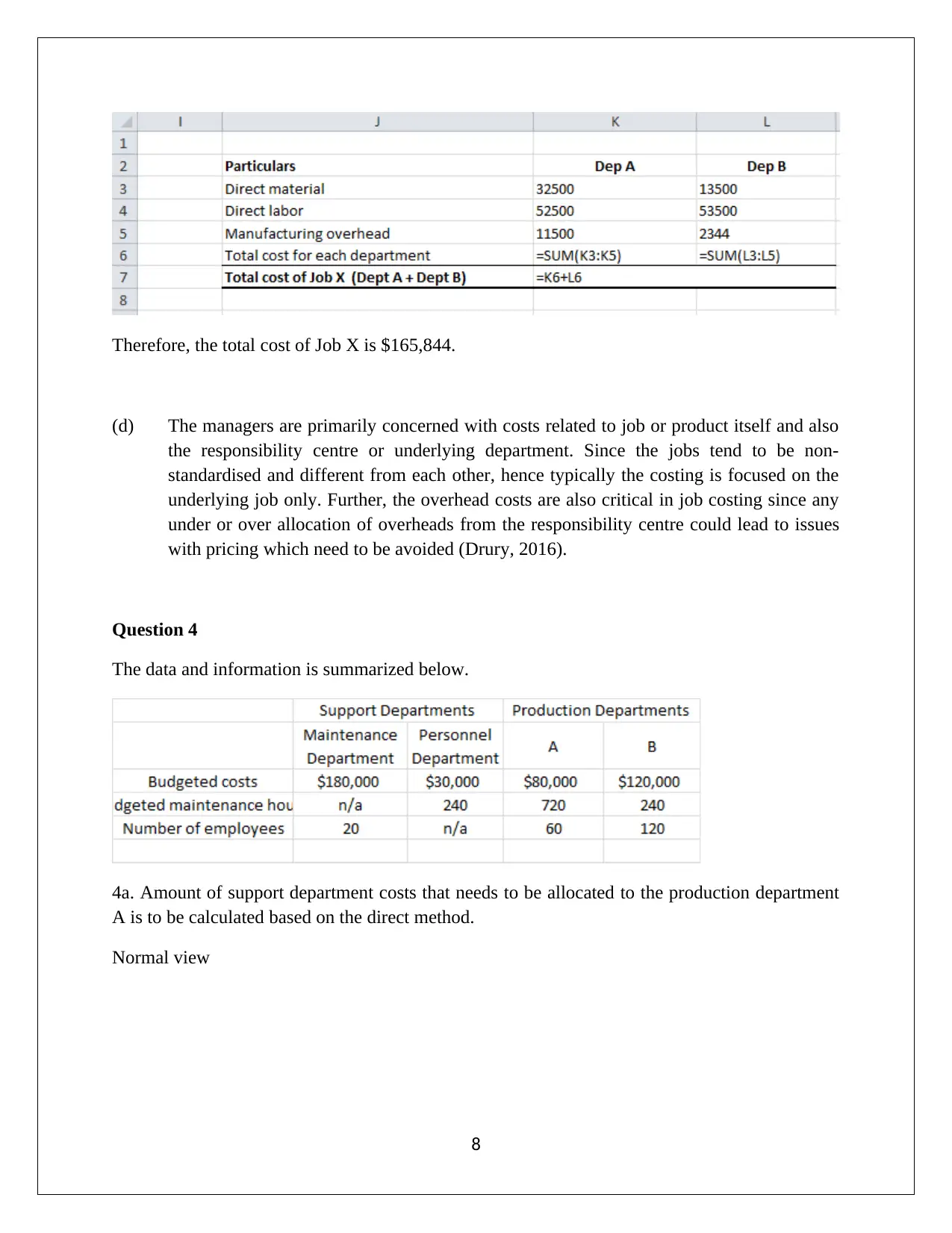
Therefore, the total cost of Job X is $165,844.
(d) The managers are primarily concerned with costs related to job or product itself and also
the responsibility centre or underlying department. Since the jobs tend to be non-
standardised and different from each other, hence typically the costing is focused on the
underlying job only. Further, the overhead costs are also critical in job costing since any
under or over allocation of overheads from the responsibility centre could lead to issues
with pricing which need to be avoided (Drury, 2016).
Question 4
The data and information is summarized below.
4a. Amount of support department costs that needs to be allocated to the production department
A is to be calculated based on the direct method.
Normal view
8
(d) The managers are primarily concerned with costs related to job or product itself and also
the responsibility centre or underlying department. Since the jobs tend to be non-
standardised and different from each other, hence typically the costing is focused on the
underlying job only. Further, the overhead costs are also critical in job costing since any
under or over allocation of overheads from the responsibility centre could lead to issues
with pricing which need to be avoided (Drury, 2016).
Question 4
The data and information is summarized below.
4a. Amount of support department costs that needs to be allocated to the production department
A is to be calculated based on the direct method.
Normal view
8
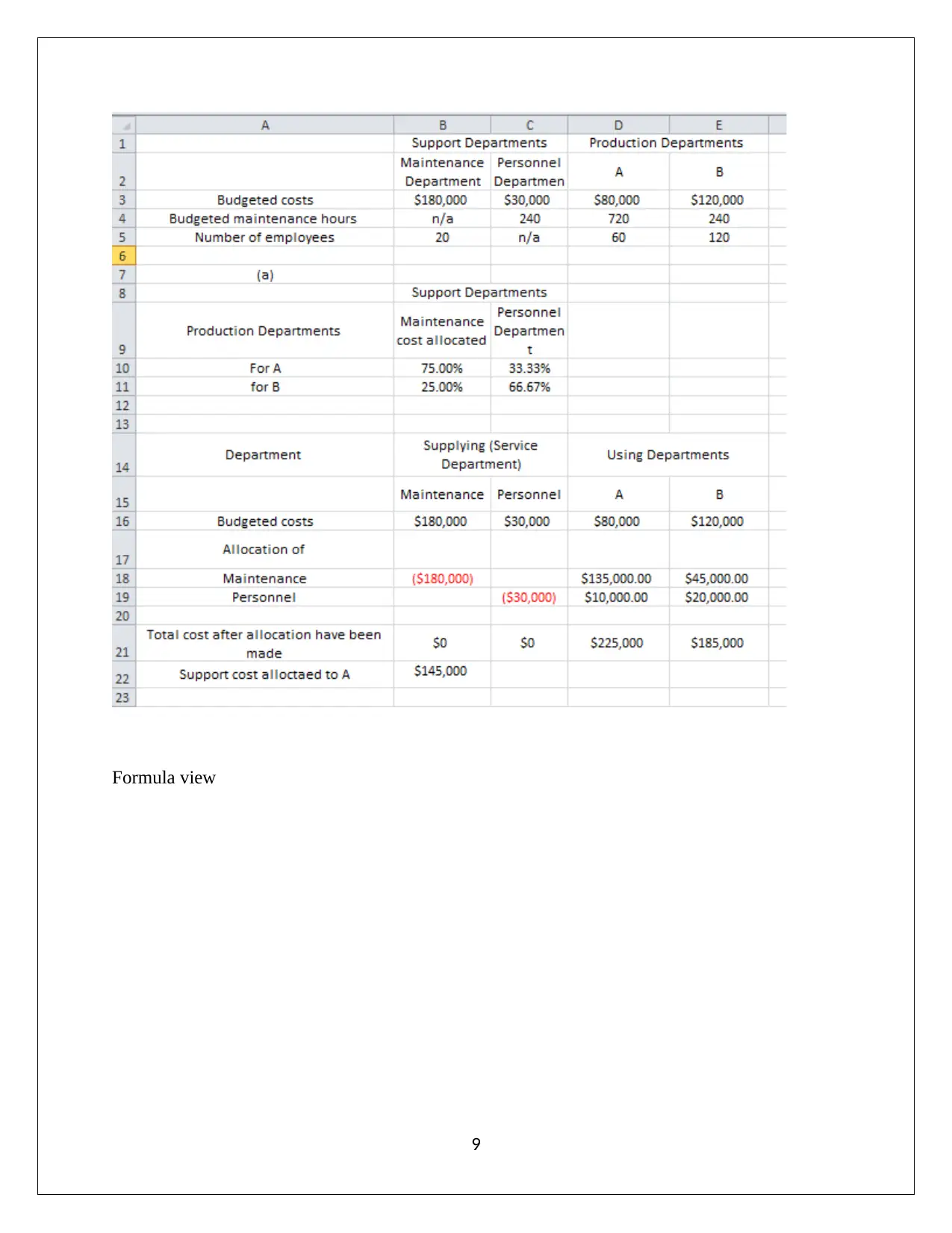
Formula view
9
9
Secure Best Marks with AI Grader
Need help grading? Try our AI Grader for instant feedback on your assignments.
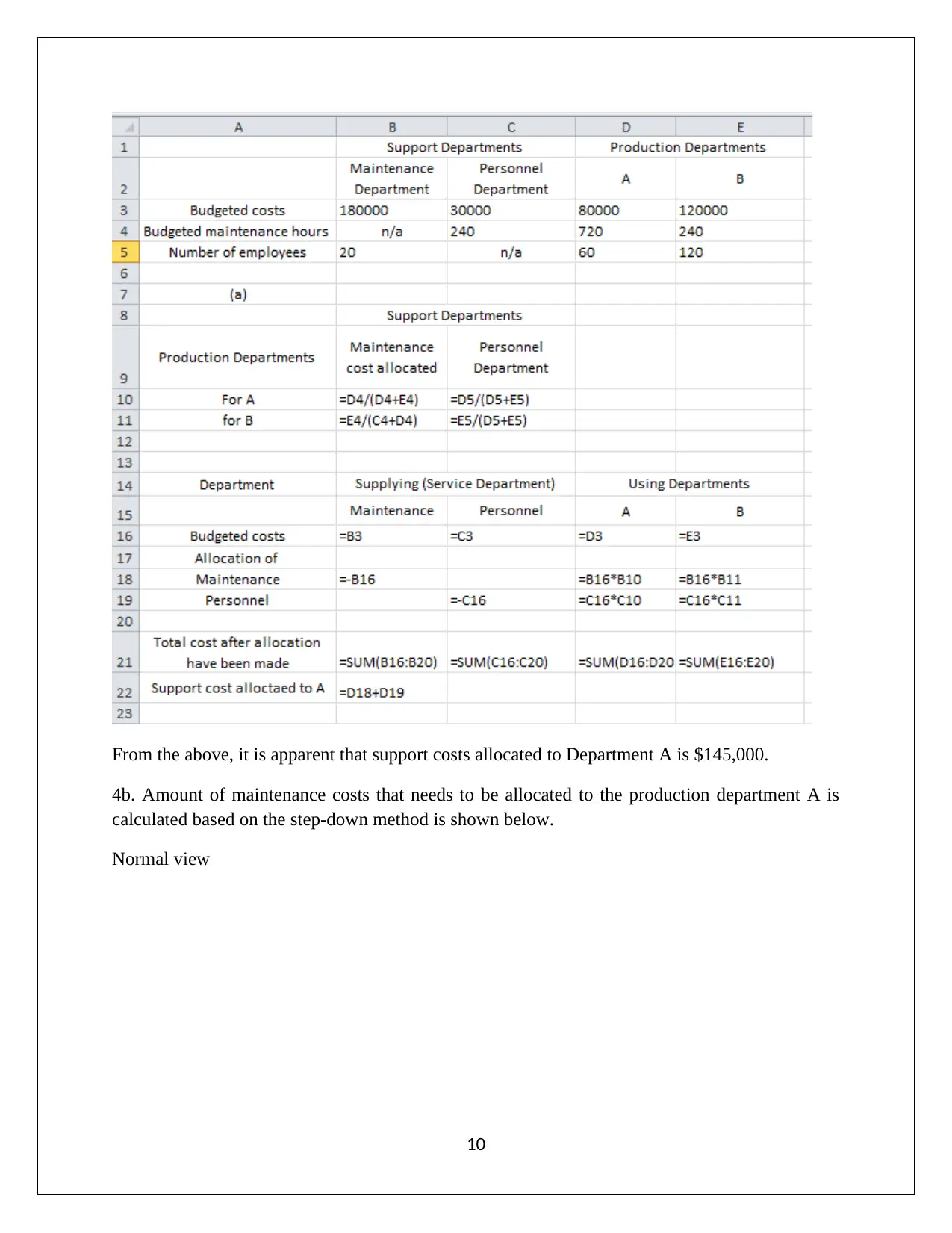
From the above, it is apparent that support costs allocated to Department A is $145,000.
4b. Amount of maintenance costs that needs to be allocated to the production department A is
calculated based on the step-down method is shown below.
Normal view
10
4b. Amount of maintenance costs that needs to be allocated to the production department A is
calculated based on the step-down method is shown below.
Normal view
10
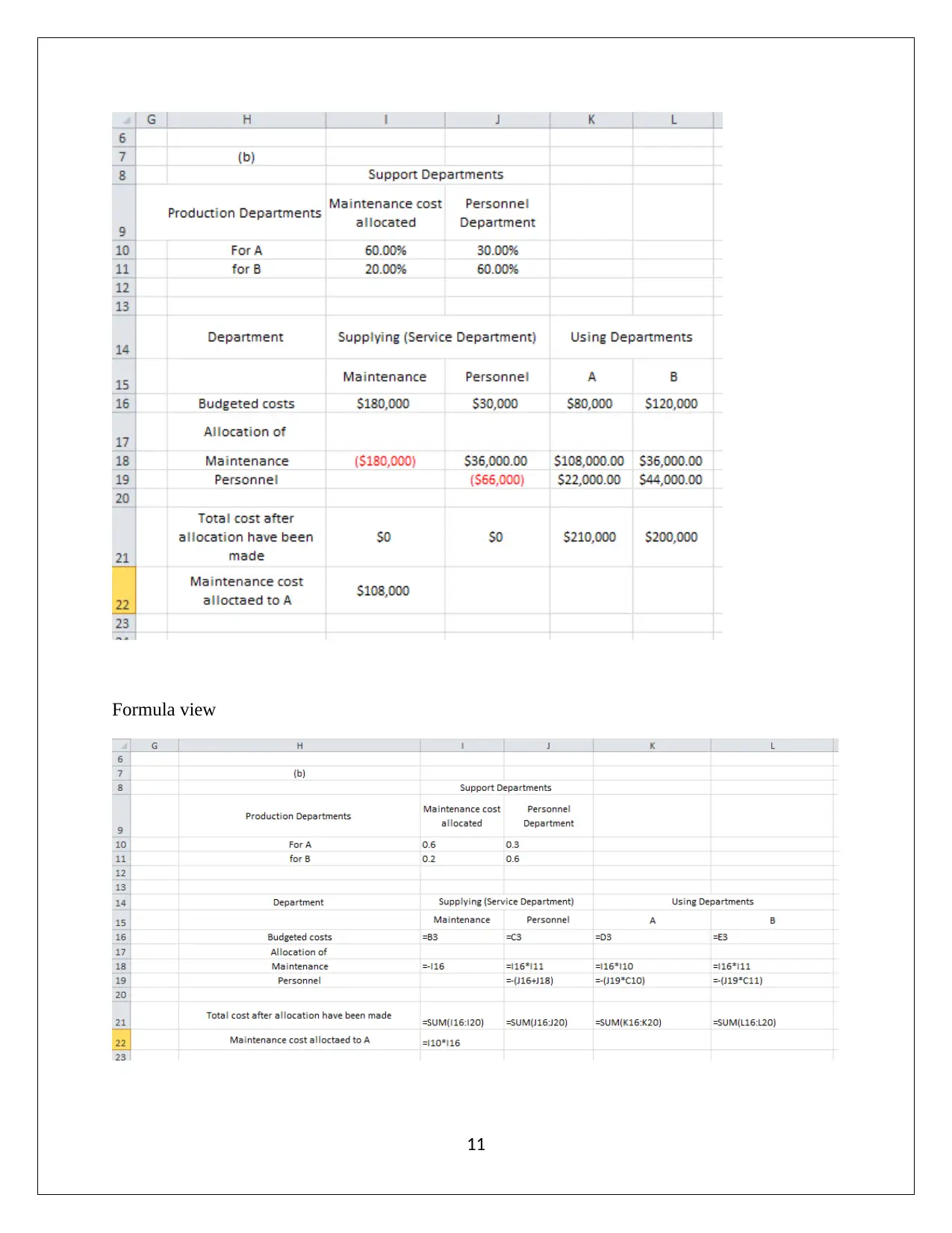
Formula view
11
11
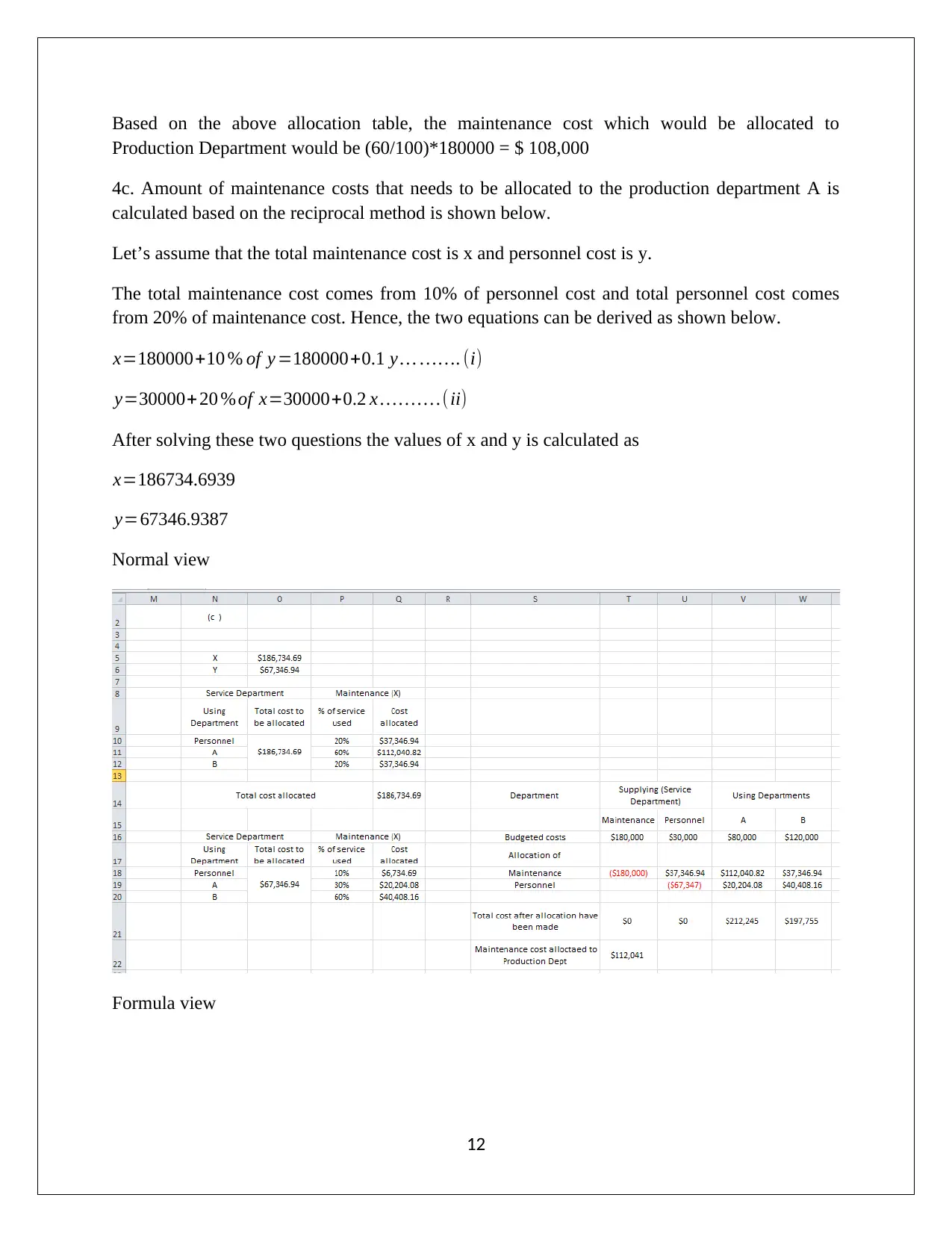
Based on the above allocation table, the maintenance cost which would be allocated to
Production Department would be (60/100)*180000 = $ 108,000
4c. Amount of maintenance costs that needs to be allocated to the production department A is
calculated based on the reciprocal method is shown below.
Let’s assume that the total maintenance cost is x and personnel cost is y.
The total maintenance cost comes from 10% of personnel cost and total personnel cost comes
from 20% of maintenance cost. Hence, the two equations can be derived as shown below.
x=180000+10 % of y =180000+0.1 y … … …. (i)
y=30000+ 20 % of x=30000+0.2 x … … … .(ii)
After solving these two questions the values of x and y is calculated as
x=186734.6939
y=67346.9387
Normal view
Formula view
12
Production Department would be (60/100)*180000 = $ 108,000
4c. Amount of maintenance costs that needs to be allocated to the production department A is
calculated based on the reciprocal method is shown below.
Let’s assume that the total maintenance cost is x and personnel cost is y.
The total maintenance cost comes from 10% of personnel cost and total personnel cost comes
from 20% of maintenance cost. Hence, the two equations can be derived as shown below.
x=180000+10 % of y =180000+0.1 y … … …. (i)
y=30000+ 20 % of x=30000+0.2 x … … … .(ii)
After solving these two questions the values of x and y is calculated as
x=186734.6939
y=67346.9387
Normal view
Formula view
12
Paraphrase This Document
Need a fresh take? Get an instant paraphrase of this document with our AI Paraphraser
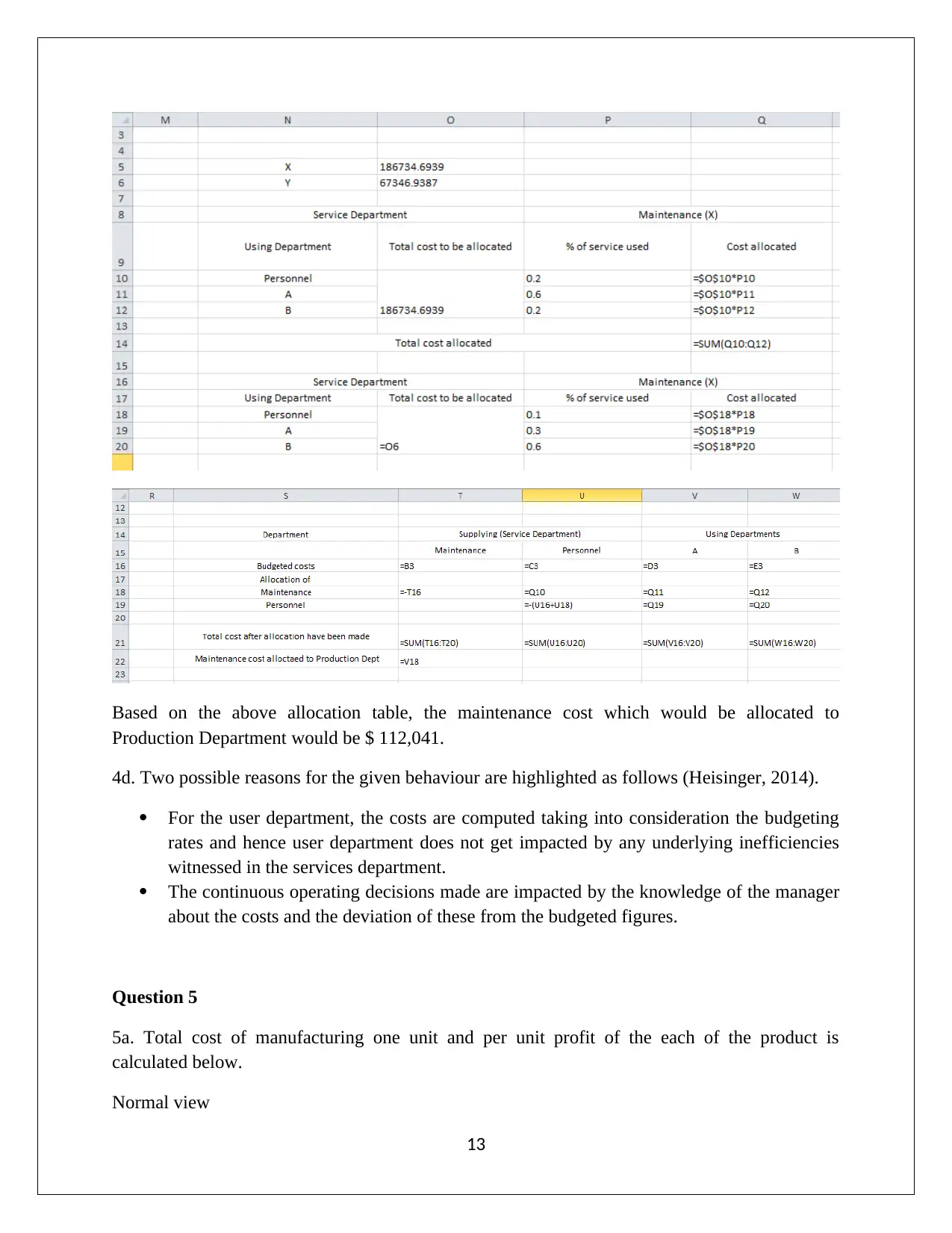
Based on the above allocation table, the maintenance cost which would be allocated to
Production Department would be $ 112,041.
4d. Two possible reasons for the given behaviour are highlighted as follows (Heisinger, 2014).
For the user department, the costs are computed taking into consideration the budgeting
rates and hence user department does not get impacted by any underlying inefficiencies
witnessed in the services department.
The continuous operating decisions made are impacted by the knowledge of the manager
about the costs and the deviation of these from the budgeted figures.
Question 5
5a. Total cost of manufacturing one unit and per unit profit of the each of the product is
calculated below.
Normal view
13
Production Department would be $ 112,041.
4d. Two possible reasons for the given behaviour are highlighted as follows (Heisinger, 2014).
For the user department, the costs are computed taking into consideration the budgeting
rates and hence user department does not get impacted by any underlying inefficiencies
witnessed in the services department.
The continuous operating decisions made are impacted by the knowledge of the manager
about the costs and the deviation of these from the budgeted figures.
Question 5
5a. Total cost of manufacturing one unit and per unit profit of the each of the product is
calculated below.
Normal view
13
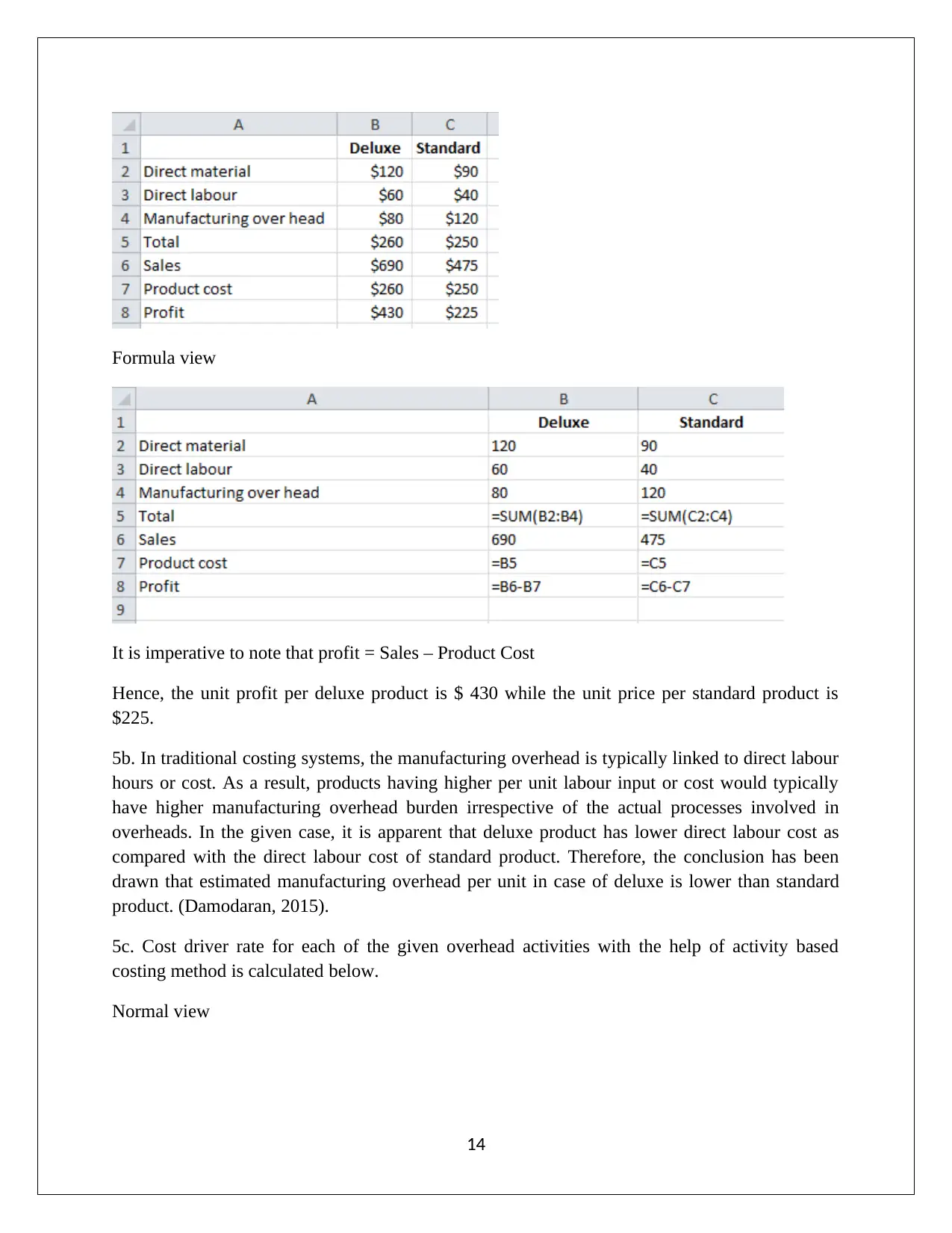
Formula view
It is imperative to note that profit = Sales – Product Cost
Hence, the unit profit per deluxe product is $ 430 while the unit price per standard product is
$225.
5b. In traditional costing systems, the manufacturing overhead is typically linked to direct labour
hours or cost. As a result, products having higher per unit labour input or cost would typically
have higher manufacturing overhead burden irrespective of the actual processes involved in
overheads. In the given case, it is apparent that deluxe product has lower direct labour cost as
compared with the direct labour cost of standard product. Therefore, the conclusion has been
drawn that estimated manufacturing overhead per unit in case of deluxe is lower than standard
product. (Damodaran, 2015).
5c. Cost driver rate for each of the given overhead activities with the help of activity based
costing method is calculated below.
Normal view
14
It is imperative to note that profit = Sales – Product Cost
Hence, the unit profit per deluxe product is $ 430 while the unit price per standard product is
$225.
5b. In traditional costing systems, the manufacturing overhead is typically linked to direct labour
hours or cost. As a result, products having higher per unit labour input or cost would typically
have higher manufacturing overhead burden irrespective of the actual processes involved in
overheads. In the given case, it is apparent that deluxe product has lower direct labour cost as
compared with the direct labour cost of standard product. Therefore, the conclusion has been
drawn that estimated manufacturing overhead per unit in case of deluxe is lower than standard
product. (Damodaran, 2015).
5c. Cost driver rate for each of the given overhead activities with the help of activity based
costing method is calculated below.
Normal view
14
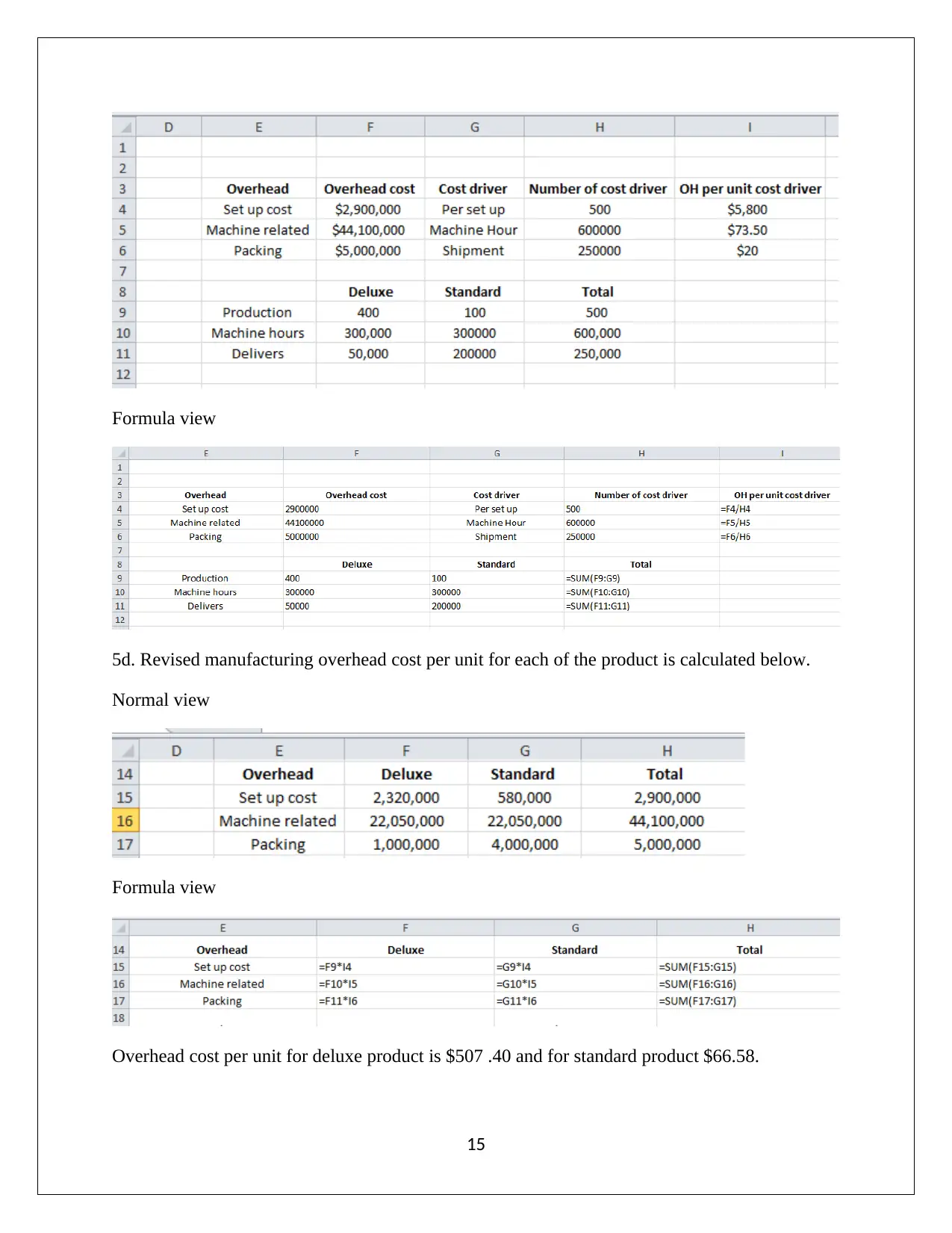
Formula view
5d. Revised manufacturing overhead cost per unit for each of the product is calculated below.
Normal view
Formula view
Overhead cost per unit for deluxe product is $507 .40 and for standard product $66.58.
15
5d. Revised manufacturing overhead cost per unit for each of the product is calculated below.
Normal view
Formula view
Overhead cost per unit for deluxe product is $507 .40 and for standard product $66.58.
15
Secure Best Marks with AI Grader
Need help grading? Try our AI Grader for instant feedback on your assignments.
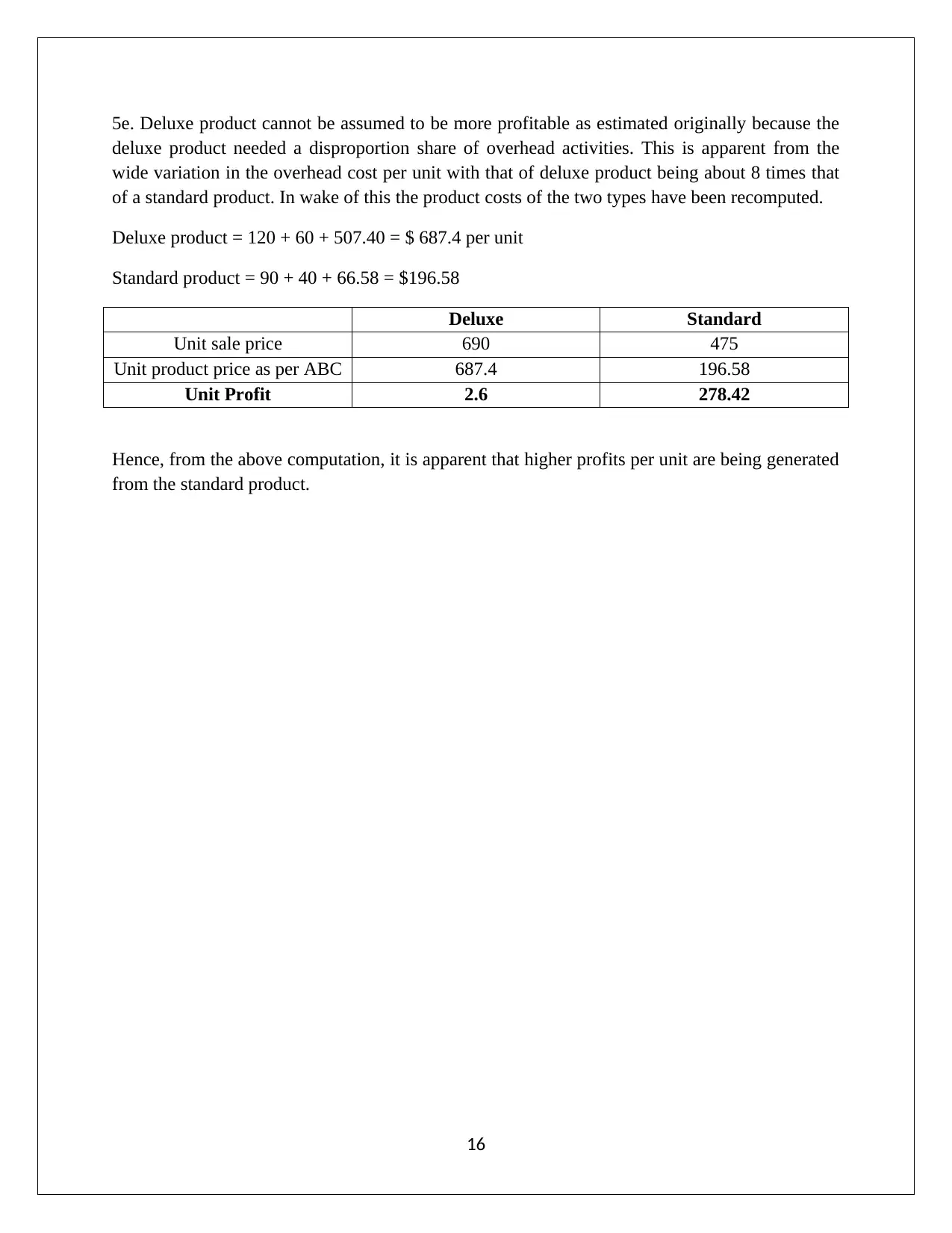
5e. Deluxe product cannot be assumed to be more profitable as estimated originally because the
deluxe product needed a disproportion share of overhead activities. This is apparent from the
wide variation in the overhead cost per unit with that of deluxe product being about 8 times that
of a standard product. In wake of this the product costs of the two types have been recomputed.
Deluxe product = 120 + 60 + 507.40 = $ 687.4 per unit
Standard product = 90 + 40 + 66.58 = $196.58
Deluxe Standard
Unit sale price 690 475
Unit product price as per ABC 687.4 196.58
Unit Profit 2.6 278.42
Hence, from the above computation, it is apparent that higher profits per unit are being generated
from the standard product.
16
deluxe product needed a disproportion share of overhead activities. This is apparent from the
wide variation in the overhead cost per unit with that of deluxe product being about 8 times that
of a standard product. In wake of this the product costs of the two types have been recomputed.
Deluxe product = 120 + 60 + 507.40 = $ 687.4 per unit
Standard product = 90 + 40 + 66.58 = $196.58
Deluxe Standard
Unit sale price 690 475
Unit product price as per ABC 687.4 196.58
Unit Profit 2.6 278.42
Hence, from the above computation, it is apparent that higher profits per unit are being generated
from the standard product.
16
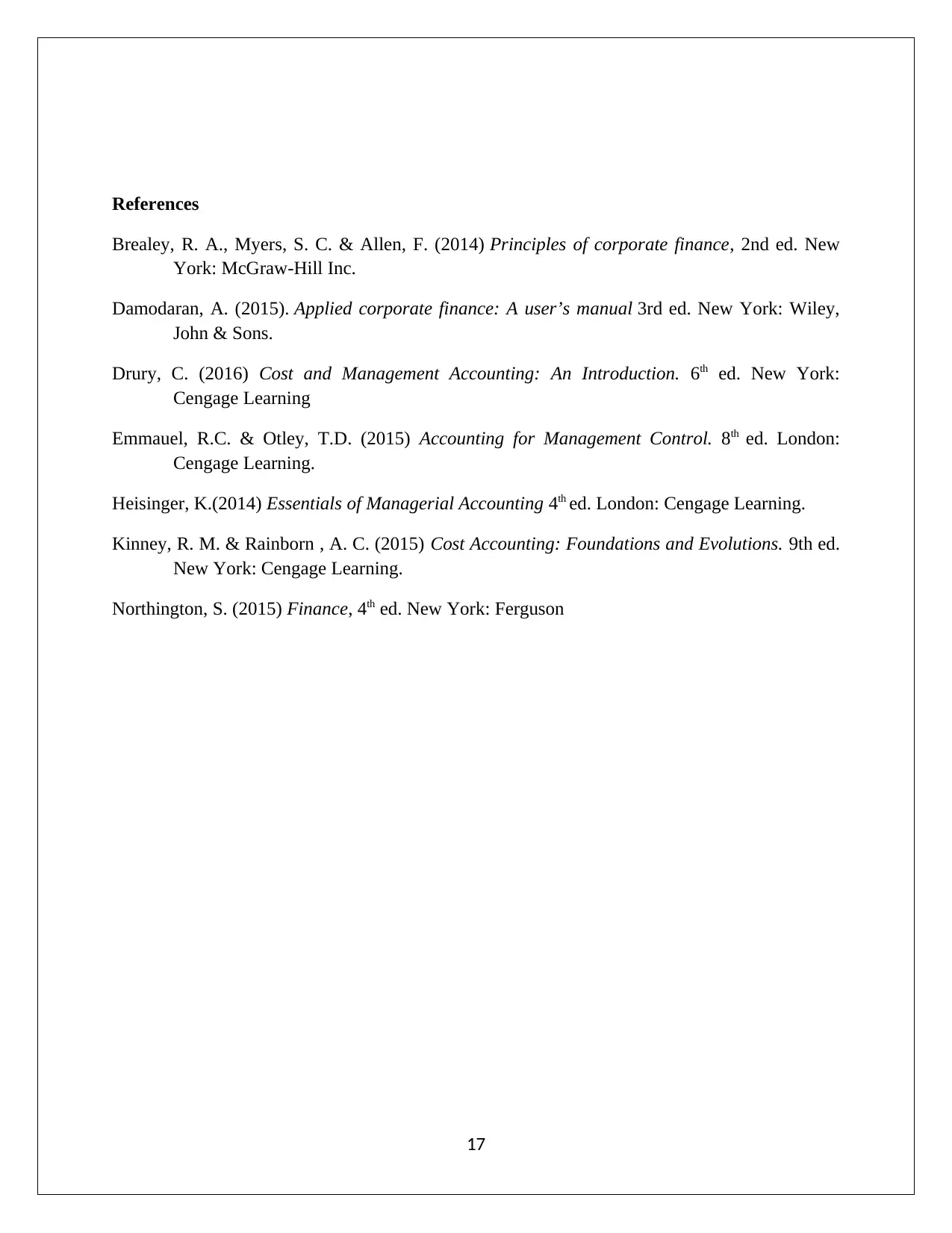
References
Brealey, R. A., Myers, S. C. & Allen, F. (2014) Principles of corporate finance, 2nd ed. New
York: McGraw-Hill Inc.
Damodaran, A. (2015). Applied corporate finance: A user’s manual 3rd ed. New York: Wiley,
John & Sons.
Drury, C. (2016) Cost and Management Accounting: An Introduction. 6th ed. New York:
Cengage Learning
Emmauel, R.C. & Otley, T.D. (2015) Accounting for Management Control. 8th ed. London:
Cengage Learning.
Heisinger, K.(2014) Essentials of Managerial Accounting 4th ed. London: Cengage Learning.
Kinney, R. M. & Rainborn , A. C. (2015) Cost Accounting: Foundations and Evolutions. 9th ed.
New York: Cengage Learning.
Northington, S. (2015) Finance, 4th ed. New York: Ferguson
17
Brealey, R. A., Myers, S. C. & Allen, F. (2014) Principles of corporate finance, 2nd ed. New
York: McGraw-Hill Inc.
Damodaran, A. (2015). Applied corporate finance: A user’s manual 3rd ed. New York: Wiley,
John & Sons.
Drury, C. (2016) Cost and Management Accounting: An Introduction. 6th ed. New York:
Cengage Learning
Emmauel, R.C. & Otley, T.D. (2015) Accounting for Management Control. 8th ed. London:
Cengage Learning.
Heisinger, K.(2014) Essentials of Managerial Accounting 4th ed. London: Cengage Learning.
Kinney, R. M. & Rainborn , A. C. (2015) Cost Accounting: Foundations and Evolutions. 9th ed.
New York: Cengage Learning.
Northington, S. (2015) Finance, 4th ed. New York: Ferguson
17
1 out of 18
Related Documents
Your All-in-One AI-Powered Toolkit for Academic Success.
+13062052269
info@desklib.com
Available 24*7 on WhatsApp / Email
![[object Object]](/_next/static/media/star-bottom.7253800d.svg)
Unlock your academic potential
© 2024 | Zucol Services PVT LTD | All rights reserved.





